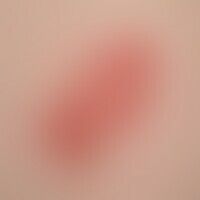Image diagnoses for "Plaque (raised surface > 1cm)", "red"
423 results with 1872 images
Results forPlaque (raised surface > 1cm)red

Parapsoriasis en plaques large L41.4

Kaposi's sarcoma (overview) C46.-
Kaposi's sarcoma HIV-associated or epidemic: Close-up. circine, brown-red patches; surface shiny, normal puckering.

Lupus erythematosus subacute-cutaneous L93.1

Squamous cell carcinoma of the skin C44.-
Squamous cell carcinoma of the skin: chronically persistent, for several years existing, slowly progressing in size, weeping and bleeding for 12 months, rough, red, rough, crusty plaque on the right forearm of an 85-year-old patient. Before histological confirmation of the correct diagnosis, the disease was misdiagnosed as psoriasis and fungal disease by several practitioners due to the unusual localization.

Psoriasis (Übersicht) L40.-
Psoriasis: chronic psoriasis plantaris with extensive infestation of the forefoot and big toe.

Psoriasis vulgaris L40.00
psoriasis vulgaris. plaque psoriasis. solitary, chronically inpatient, intermittent, sharply delineated, reddish, silvery scaly plaques localized in the face in a 6-year-old girl. erythrosquamous plaques also appear on the extensor sides of the arms and legs. symmetrical infestation. positive family history.

Lupus erythematodes chronicus discoides L93.0
Lupus erythematodes chronicus discoides: persistent, progressive skin changes in a 67-year-old patient for 15 years; large, hyperesthetic, red, centrally ulcerated plaque.

Intertrigo L30.49
Intertrigo: bright red blurred flake-free (pretreatment), submammary plaque with satelliteosis (circles), probably superimposed by yeast infection.

Pityriasis rosea L42
Pityriasis rosea: A maculo-papular to plaque-like, slightly to moderately scaly exanthema with coin-like filled foci that persists for a few weeks; in the breast area also large, anular formations.

Kaposi's sarcoma classic C46.-
Kaposi sarcoma classic: large, red moderately sharply defined, painless plaques.

Sweet syndrome L98.2
Dermatosis, acute neutrophils: reddish-livid, succulent, pressure-dolent, infiltrated, solitary and partly confluent papules, which confluent to plaques. 1 week before the onset of the disease a fever attack with temperatures > 38 °C occurred.

Bowen's disease D04.9
Bowen's disease: Chronically stationary, slowly increasing in area and thickness, sharply defined, meanwhile clearly increased in consistency, symptomless, red, rough, partly scaly, partly erosive, partly crusty plaques on the left thumb extension side of a 63-year-old man; characteristic is the occurrence mainly in the area of light-exposed skin areas.

Bowen's disease D04.9

Lupus erythematosus (overview) L93.-
Lupus erythematosus, subacute cutaneous lupus erythematosus: acute episode of non-scarring cutaneous lupus erythematosus, known significantly increased photosensitivity.

Lupus erythematosus acute-cutaneous L93.1
lupus erythematosus acute-cutaneous: clinical picture known for several years, occurring within 14 days, at the time of admission still with intermittent course. anular pattern. in the current intermittent phase fatigue and exhaustion. ANA 1:160; anti-Ro/SSA antibodies positive. DIF: LE - typical.

Tinea pedis oligosymptomatic type B35.30
Tinea pedis oligosymptomatic type: no subjective sympotaxis. findings rather coincidental. circinar, grazing scaling. typical are raised scaling ruffs of the areas (marked by arrows). small plantar wart marked by circle, positive mycological evidence in the zone of the small toe marked by square.

Porom eccrines D23.L
Porom ekkrines: red papule with scaly surface, existing since > 1 year, little symptomatic. 52 year old patient.







